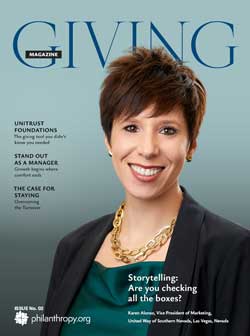With Brad Caswell
A lot of donors are leaving undistributed assets in their DAFs — defeating the intent of a donor-advised fund.
Last year, less than 23% of fund totals were distributed out of the nearly one and half million donor-advised funds in the U.S. Why aren’t donors giving more DAF assets away?
Donor-advised funds, or DAFS, are a giving vehicle that’s rapidly growing in popularity. A DAF is, in essence, a mini foundation: the donor gifts the assets into the fund and then chooses where and in what amount those charitable dollars are distributed. It is artistic in its simplicity and a potent way for donors to make a difference.
So why aren’t they making more distributions?
For organizations that offer DAFs, and organizations that accept grants from DAFs, you may find some answers below.
If You Hold Donor-Advised Funds at Your Organization
Problem One
Donors are just … forgetting?
DAFs are well known for having the usual charitable tax benefits and can leverage both bunching and carrying forward: make a large gift one year to get a large income tax deduction. That deduction is also eligible to be carried forward, where the deductible amount can be spread out over up to five years. For donors facing a year with a sudden, one-time increase in taxable income (such as selling a business or major asset), it is often advantageous for them to balance out this windfall with a large tax-deductible gift — and you can see where this is going.
Later, as the dust settles on tax season, some donors move on and go back to their normal charitable check-writing — completely forgetting that they set up the DAF as a tool that does this for them already.
Similarly, it happens frequently that donors fall in love with the idea of a donor-advised fund and take advantage of the simple start-up process to set their fund up. After the initial pride in their savvy giving, when approached by annual appeals and gift officers they unconsciously revert to their traditional means of giving, rather than using their DAF assets.
Solution: Send reminders to your fundholders.
It’s especially important to send these reminders at fiscal year-end and holidays! It is a fantastic opportunity to encourage gifts into their fund while also generating more grant money for other nonprofits (which is a number you can proudly report!).
Problem Two
Donors are taking advantage of tax benefits and the option of earning tax free interest on their account balances and, even though they do not get the DAF assets back, also choose not to distribute their dollars they’ve already committed to charity.
Some donors are using DAFs to reduce taxable income in “windfall” years, without prioritizing charitable intent.
It is not a misuse of this tool, per se, but Washington is taking notice. Soon, these parked and forgotten dollars may have a distribution timeline enforced. While this can be good news for the charities that will be supported by these distributions, donors may find that this giving vehicle no longer meets their giving strategies.
Solution: Send reminders to your fundholders.
Like Problem One, frequent encouragement from your organization to put those dollars to use can go a long way. Be sure to stress the positive effect and the need for their charitable dollars when distributed among the community!
Problem Three
Donors do not assign an “heir.”
This may be the result of incomplete conversations when creating a DAF agreement with the donor, or simply an oversight in the DAF account setup.
Solution: Require a successor advisor.
Every nonprofit that holds DAFs should require a successor advisor be named for a donor-advised fund upon creation, or have the donor make clear, in writing, how the funds should be liquidated to the charity upon their passing.
Problem Four
Donors do not have the means to be readily active in their DAF giving.
What is your current process for informing donors about the status and history of their DAF? If your donor needs to reach out every time they want to make a gift or check a balance, and then wait a few days for a response, they are going to be less inclined to make their DAF their main tool in charitable giving — which defeats its purpose.
Solution: Online portals.
Technology is an essential element of today’s DAFs. Functional and user-friendly online portals are a wonderful way to keep donors interested in their DAF assets. If your organization does not have the funds to upgrade your technology, at least make sure any questions and communications are answered by your organization within one business day.
Problem Five
Donors fall out of touch with your organization.
It happens. People change their contact information and forget to advise all of their contacts, or maybe they just pass on and you’re never told. Heirs and estate executors may not be aware of the account with your organization.
Solution: Know who has become inactive among your donors.
Reach out and stay in touch. There are many tools and platforms to research people, including death records etc.
If You Are an Organization That Accepts Grants from Donor-Advised Funds
Problem One
Donors are not being stewarded (enough).
A donor who gives to your charity through a DAF grant is a donor that you need to stand up and notice. Holding a donor-advised fund not only means your donor is so charitably inclined that they felt a fund just for philanthropic dollars would benefit them; it also means that chances are, your donor had your organization in mind when creating the fund and will be willing to give again. And, it’s very likely they have more funds in their DAF account from which to make further donations to you.
However, if the donor goes through all that effort and interest and they aren’t thanked and they hear nothing from your organization, they may feel they are not having the impact for which they are hoping, or feel that you do not appreciate their contributions. Seeking to do the most good and desiring a bit of self-satisfaction, they may take their charitable spending elsewhere.
Solution: Contact your donors!
Take the small amount of time required to send your DAF donors a personalized email, postcard, voicemail, or whatever you can manage to make them feel seen. Continue that outreach and you will have a donor for life.
Donor-advised funds are still scaling upward in popularity. In an increasingly donor-centric fundraising environment, it becomes the duty of organizations to make sure these tools are being maximized to create the most good: for the donor, and for the causes we represent.



